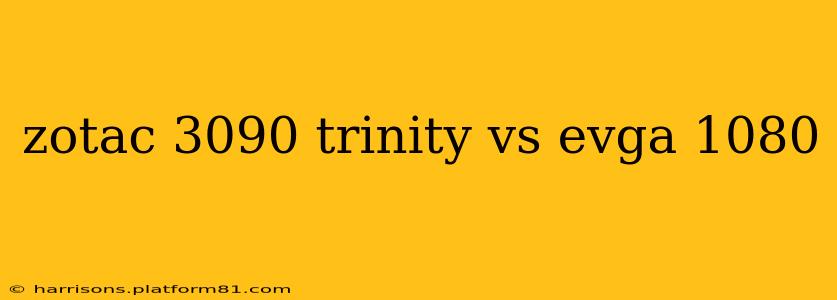Zotac RTX 3090 Trinity vs. EVGA GTX 1080: A Generational Face-Off
The Zotac RTX 3090 Trinity and the EVGA GTX 1080 represent two distinct generations of NVIDIA graphics cards. Comparing them directly highlights the massive leaps in graphics processing power over the years. While the price difference might seem substantial, understanding the performance disparity justifies the investment in newer hardware for demanding tasks. Let's dive into a detailed comparison, addressing some common questions.
What are the Key Differences Between the Zotac RTX 3090 Trinity and EVGA GTX 1080?
The core difference lies in architecture and raw power. The EVGA GTX 1080, a stalwart of its time, utilizes the Pascal architecture. The Zotac RTX 3090 Trinity, on the other hand, is built on the Ampere architecture, a significant generational jump. This leads to substantial improvements in:
- Raw Processing Power: The RTX 3090 boasts drastically more CUDA cores, higher clock speeds, and vastly improved memory bandwidth compared to the GTX 1080. This translates to significantly higher frame rates in games and far superior performance in computationally intensive tasks like video editing and 3D rendering.
- Ray Tracing and DLSS: The RTX 3090 supports ray tracing, a technology that simulates realistic light interactions, creating stunning visuals. It also features DLSS (Deep Learning Super Sampling), a technology that boosts frame rates without significantly sacrificing image quality. The GTX 1080 lacks both of these features.
- Memory: The RTX 3090 typically comes with 24GB of GDDR6X memory, compared to the GTX 1080's 8GB of GDDR5X. This larger and faster memory capacity allows for smoother performance in high-resolution gaming and demanding applications.
Is the Zotac RTX 3090 Trinity Worth the Upgrade from an EVGA GTX 1080?
For gamers and professionals pushing the boundaries of graphics performance, the upgrade is undeniably worthwhile. The generational leap offers a massive performance boost. However, the price difference is significant. Consider your budget and the tasks you use your GPU for. If you primarily play older games at lower resolutions, the investment might not be immediately necessary. But for modern AAA titles at 4K resolution, or professional workloads, the RTX 3090 offers an unparalleled advantage.
What are the performance differences in games?
The performance gap between these two cards is vast. Expect to see at least a 2x to 3x performance increase in most modern games at 1080p, and an even greater improvement at 1440p and 4K resolutions. The RTX 3090 can handle the highest settings with ease in most games, where the GTX 1080 would struggle to maintain playable frame rates. This disparity is even more pronounced when ray tracing is enabled.
Which card is better for 4K gaming?
The Zotac RTX 3090 Trinity is far superior for 4K gaming. The GTX 1080 struggles to maintain acceptable frame rates at 4K even with settings lowered. The RTX 3090, with its superior processing power and large memory capacity, handles 4K gaming with significantly improved performance and visual fidelity.
What about power consumption and heat output?
The RTX 3090 has considerably higher power consumption and heat output than the GTX 1080. This means you'll need a more robust power supply and potentially a better cooling solution. It's crucial to check the TDP (Thermal Design Power) of the RTX 3090 and ensure your system can handle it.
Which card is better for video editing and 3D rendering?
The RTX 3090 significantly outperforms the GTX 1080 in professional applications like video editing and 3D rendering. The additional CUDA cores, faster memory, and improved architecture translate to much faster rendering times and smoother workflows.
In conclusion, while the EVGA GTX 1080 served its time admirably, the Zotac RTX 3090 Trinity represents a substantial leap forward in graphics technology. The upgrade is justified for those who demand the highest performance in gaming, video editing, or 3D rendering, provided their budget allows for the significant price difference. Consider your specific needs and budget carefully to make the most informed decision.
